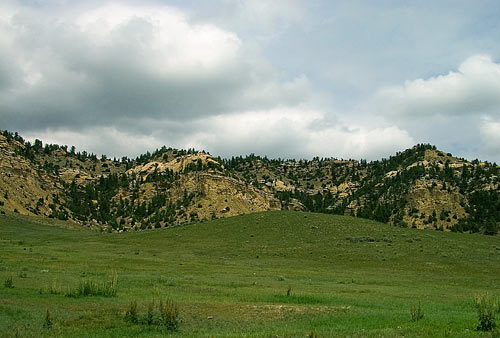Wyoming’s wolf conservation plan has now been rejected twice by USFWS, mostly because it in effect limits wolves in Wyoming to Yellowstone National Park, which Wyoming hopes will maintain the mininum number of wolf packs required for recovery in the state.
Granted the Wyoming plan would allow wolves to wander as “trophy big game” animals in the 3 wilderness areas immediately adjacent to YNP, but not a single wolf pack uses these wilderness areas year round. Outside of these areas (and Grand Teton National Park, which is too small to entirely contain one wolf pack), wolves could be killed year round for any reason by anyone.
Worse still, the Wyoming plan would also allow the killing of Yellowstone Park wolves if they leave the Park, and the Druid Pack and Mollies Pack both often leave to the east and wander outside the “protected” North Absaroka, Washakie, and Teton Wilderness areas.
The Wyoming wolf population stopped growing a few years back, but this year it resumed growth, and now there are over 300 wolves (including YNP wolves) in the “energy company” state.
Wyoming Game and Fish likes to argue that wolves are reducing the elk population, but in fact the elk population in the state remains above the “target” of the Department. Wolves may be the only thing being done in Wyoming to control the spread of chronic wasting disease, especially the new wolf packs which live on the eastern outskirts of the Greater Yellowstone. That is where CWD is moving in. It has been hypothesized that wolves might be able to detect a “mad elk” or mad deer before it becomes highly infective, and kill it. This has not been proven, and under the head-in-the-sand stance of Wyoming government, we will not get the chance to know.
Here is the story by Cat Urbigkit in the Jackson Hole Star Tribune.
If Wyoming’s plan gets approval, over 150 wolves could be shot, run-over, tortured, etc. by anyone for any reason.

The Gooseberry Creek Country, where the new Gooseberry Pack may be the front line (and only line) defense against the spread of chronic wasting disease. Photo by Ralph Maughan
This area is SE of the town of Meeteetse.

Comments
Amazing,, they just won’t give in and all the while another year of potential wolf management by the state passes by.. Wyoming now wants to intervene if wolves are “harrassing” elk on the feedgrounds.”????? What tha? So I suppose it’s better to bump ’em away from their prey base, so they can move on to beef? Not to mention, this would allow large groups of elk to stay nice and bunched up to spread disease. I wonder how these folks will look at wolves when disease becomes the limiting factor in elk herds?
Reading this reiterates the fact that There are many in Wyoming who have had and still have harsh feelings towards the Federal government which is what I feel a large part of this is due to.
Less elk hunting opportunities for people has to do with LAZY people who don’t want to change their hunting techniques due to changed behavior in elk.. Hunting in my opinion never has been nor ever should be a guaranteed thing, it SHOULD require hard work and I for one don’t mind competition from wolves.
Add to Ronnie’s note this fact: The number of hunters is declining across the country. In Pennsylvania, about 1.1 million hunters went out for white-tailed deer as recently as 10 years ago. Now, the number has fallen to about 900,000 and shows signs of slipping further. This is bad news for agencies, like the Pennsylvania Game Commission, that get all of their funding revenue from the sale of licenses and tags. All the more reason for states to choose the Missouri model for funding their wildlife agency. In Missouri, the Department of Conservation gets two-thirds of its budget from the revenue raised by the conservation sales tax (one-eighth of one percent).
On top of this, more and more hunters are becoming lazier and lazier, choosing to hunt from spots as close to a road as they can get.
Ralph,
I noticed you posted the mid-year report for the Yellowstone and Idaho wolf populations recently but nothing for the Wyoming population. Here is the mid-year report for the Wyoming population from the USFWS Gray Wolf Weekly Report, 9/15-9/22 if you would like to post it:
Wyoming (outside YNP) = 166 wolves; 17 packs producing 51 pups; 4 more suspected packs. Growth rate = 23%. Confirmed Packs- 1) Beartooth- 5, ?, 5; 2) Sunlight Basin-11, 5,16; 3) Absaroka- 6, 3, 9; 4) Greybull River- 2, 6, 8; 5) Rock Creek- 3, 2, 5; 6) South Fork- 7, 3, 4; 7) New South Fork- 3, 2, 5; 8 ) Gooseberry- 2, 5, 7; 9) Teton- 5, 0, 5; 10) Buffalo- 8, 9,17; 11) Pacific Creek- 9, 4,13; 12) Washakie- 6, 5, 11; 13) East Fork- 8, ?, 8; 14) Black Butte- 3, ?, 3; 15) Gros Ventre- 2, 4, 6; 16) Bliss Creek- 4, 2, 6; 17) Prospect- 3, 1, 4; Suspected packs 18) Cub Creek- 3, ?, 3; 19) Flat Creek- 6, ?, 6; 20) Sage- 2, ?, 2; 21) Togwottee- 4, ?, 4; Misc. Wolves Carter Mtn.- 2, 0, 2; Big Piney- 4, ?, 4; Daniel- 4, ?, 4; Kemmerer/Hamsfork- 2-4, ?, 2- 4; Big Horn Mtns.- 1-2, 0,1-2.
Dale
Thanks for posting it. I meant to do a story on Wyoming wolves too, but didn’t get a good connection with Mike Jimenez for a good analysis. Ralph M.